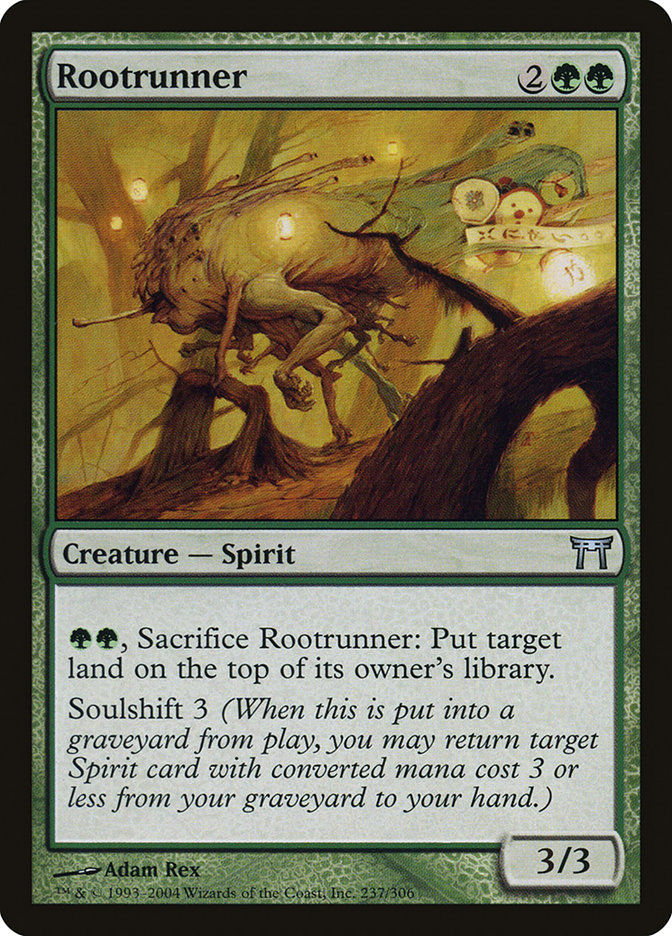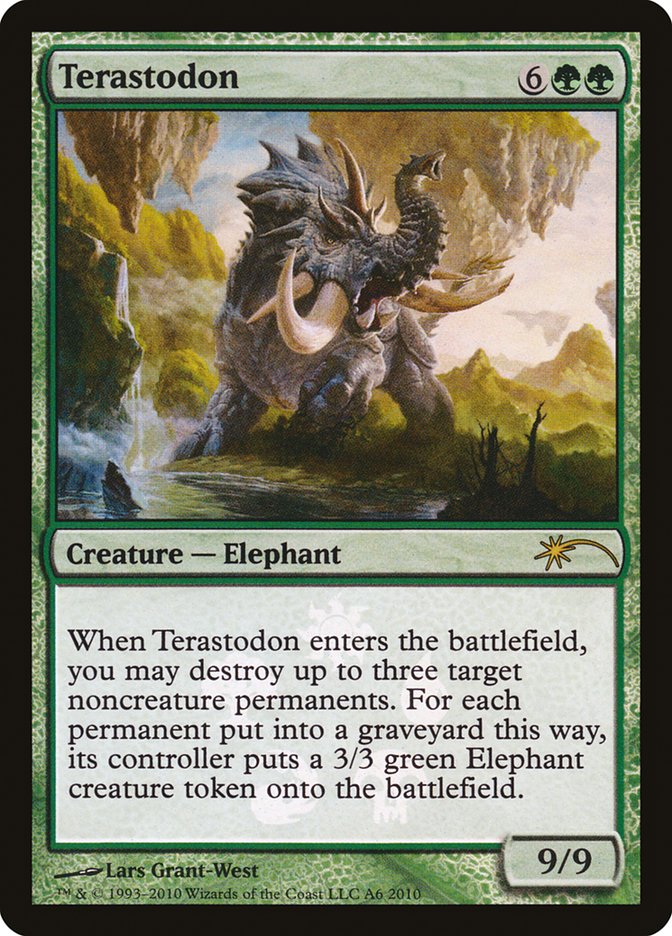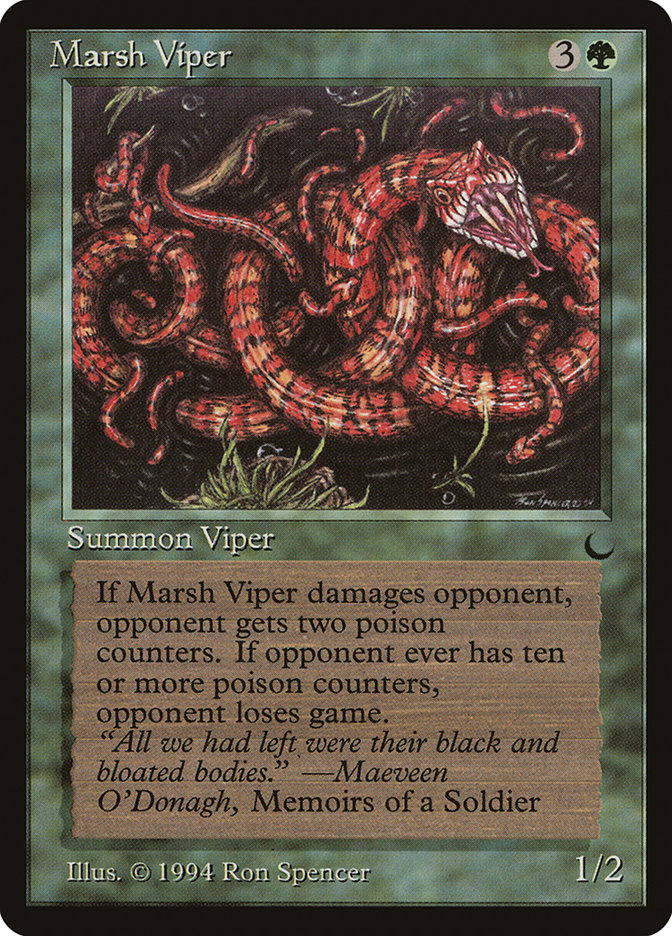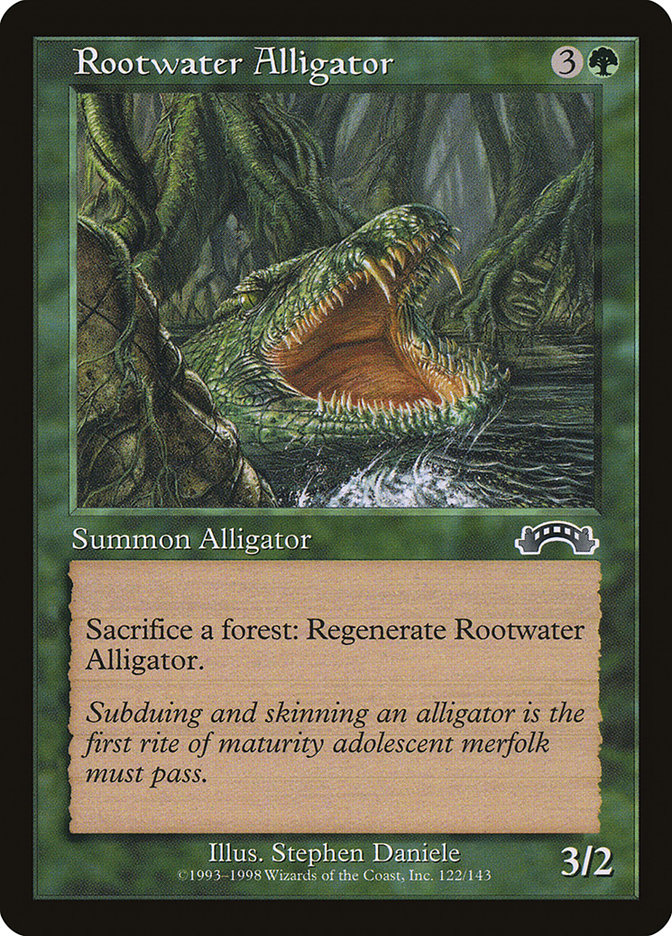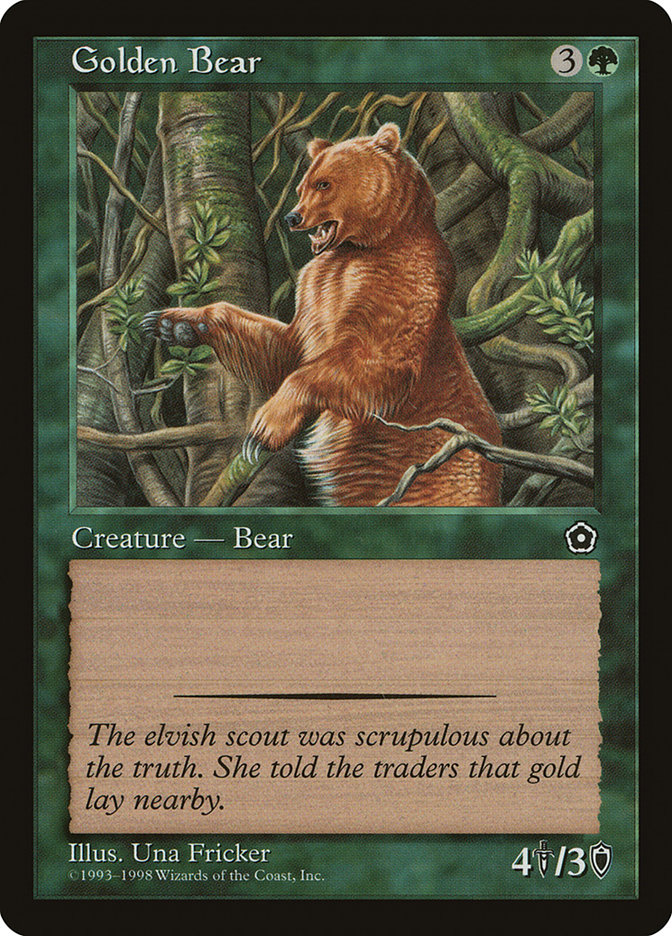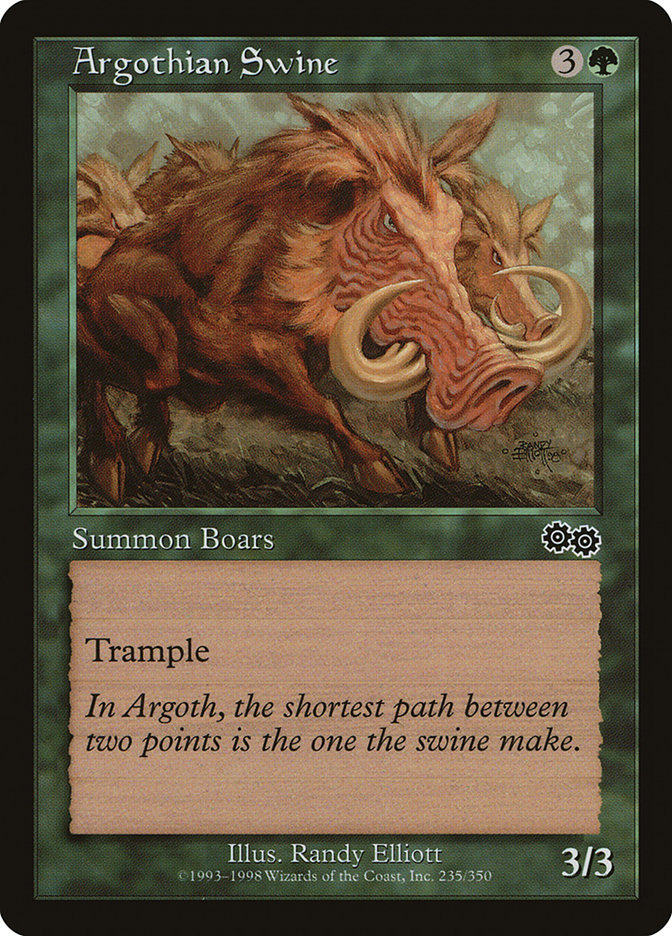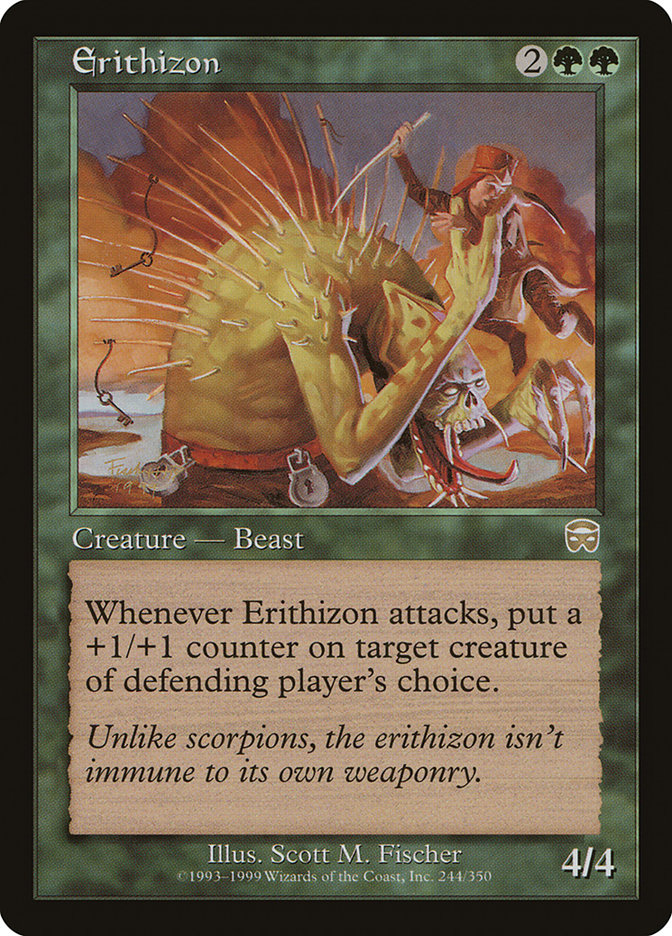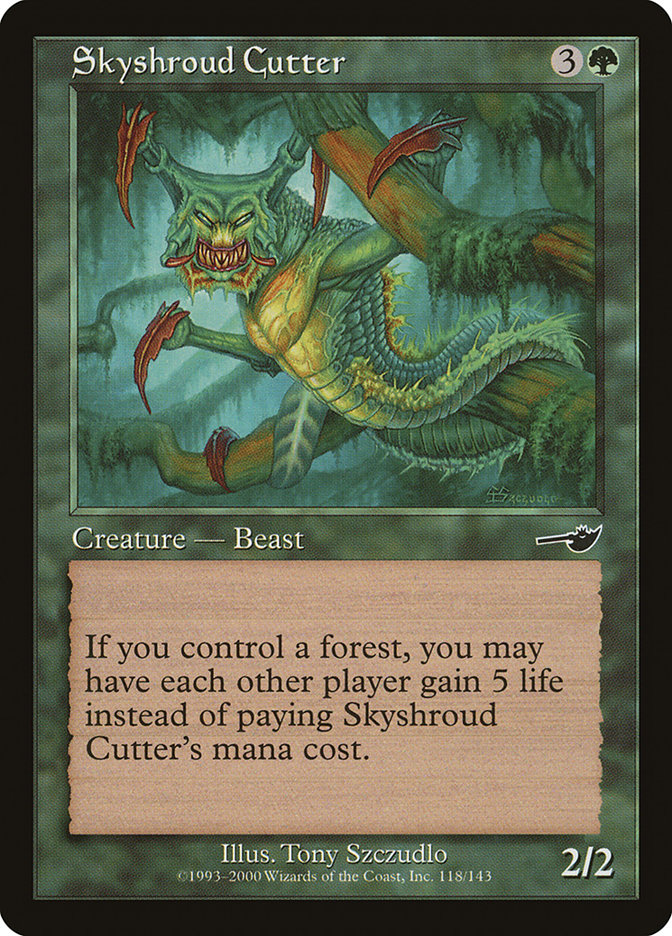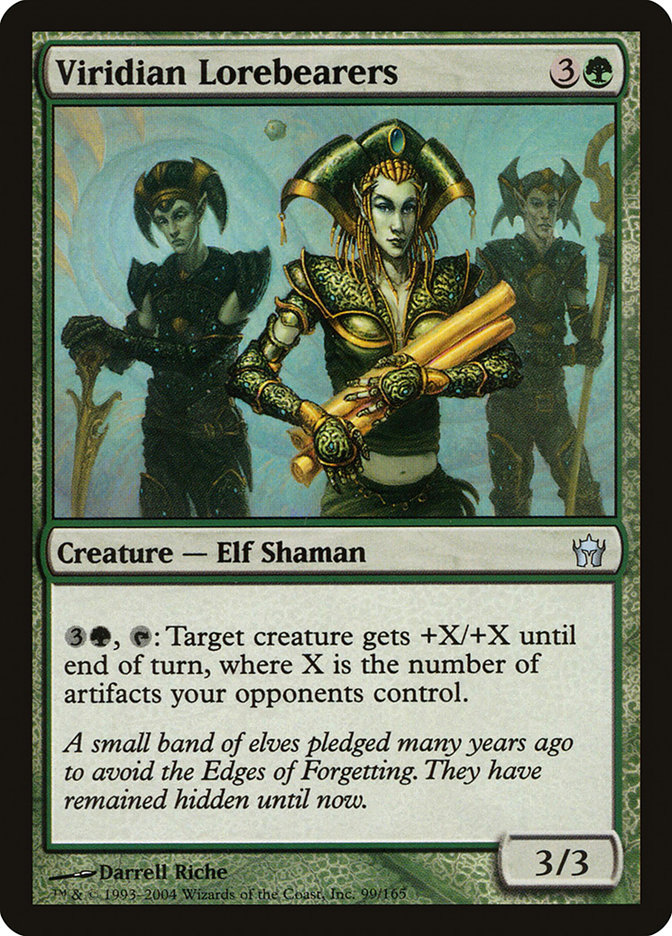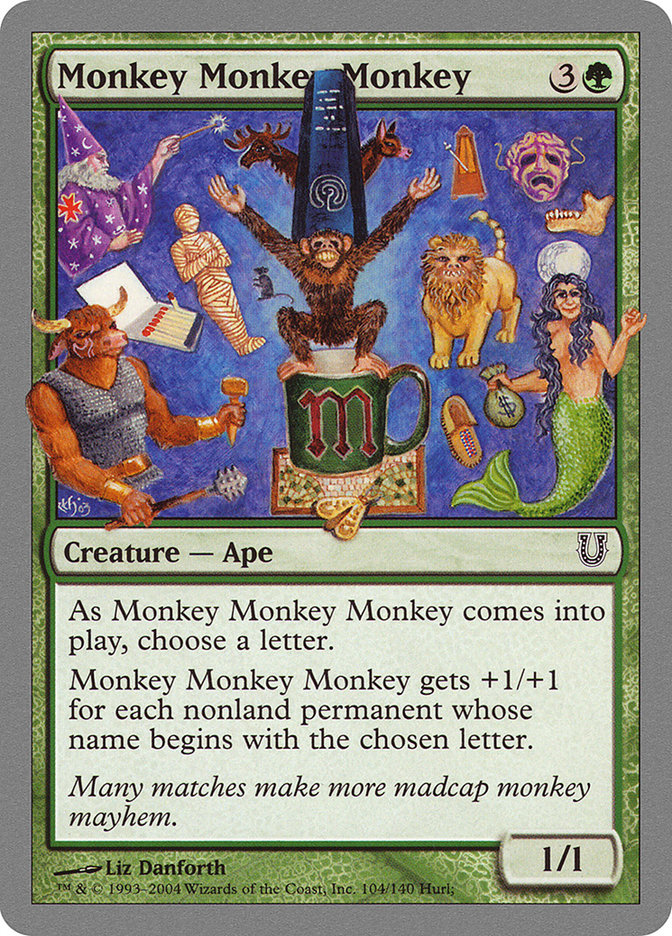Corredor de raíces Carta MTG
| Colecciones da carta | Lanzado en 2 coleccionesVer todos |
| El coste de maná | |
| Costo de maná convertido | 4 |
| Rareza | Poco común |
| Tipo | Criatura - Espíritu |
| Habilidades | Soulshift |
| Fuerza | 3 |
| Tenacidad | 3 |
Texto de la carta
{G}{G}, sacrificar el Corredor de raíces: Pon la tierra objetivo en la parte superior de la biblioteca de su propietario. Migración de almas 3 (Cuando esto vaya a un cementerio desde el juego, puedes regresar la carta de Espíritu objetivo con coste de maná convertido de 3 o menos de tu cementerio a tu mano.)
Cartas Similares
Rootrunner se destaca como una criatura única en MTG con su potencial para perturbar estrategias basadas en tierras. Si observamos cartas como Acidic Slime, encontramos algunas similitudes, ya que Acidic Slime también proporciona un método para lidiar con tierras al destruir cualquier objetivo, incluidas las tierras. Sin embargo, Acidic Slime tiene la versatilidad de eliminar artefactos y encantamientos, a diferencia de Rootrunner que se enfoca únicamente en tierras. Además, Acidic Slime ofrece contacto mortal, lo que lo convierte en un bloqueador más formidable.
En comparación, Terastodon también te permite interactuar con tierras, pero a una escala más grande. Mientras que Rootrunner puede poner una tierra en la parte superior de la biblioteca de su propietario, Terastodon puede destruir directamente hasta tres permanentes no criatura seleccionados, reemplazándolos por elefantes 3/3. Esto no solo interrumpe los juegos de tierras, sino que puede alterar significativamente el estado del tablero con potencial para presión ofensiva.
En general, Rootrunner tiene un papel especializado, especialmente en mazos centrados en el control de tierras. Su habilidad de hacer rebotar tierras repetidamente con su habilidad de sacrificio le otorga una posición única entre sus pares. Sin embargo, está claro que en MTG, hay varios enfoques para la interacción con tierras, ofreciendo a los jugadores diferentes ventajas tácticas.
Cartas similares a Corredor de raíces por color, tipo y coste de maná
Aspectos Positivos de la Carta
Ventaja de Carta: Rootrunner proporciona profundidad estratégica al potencialmente perturbar la base de maná de tu oponente, haciéndoles más difícil lanzar hechizos o responder a tus movimientos de manera efectiva. Esto puede resultar en una forma de ventaja de carta al obligar a tu oponente a perder turnos restableciendo su base de maná mientras tú continúas desarrollando tu tablero y avanzando con tu plan de juego.
Aceleración de Recursos: Desde una perspectiva de aceleración de recursos, Rootrunner puede servir como un contratiempo temporal para el desarrollo de recursos de tu oponente. Al devolver una tierra a su mano, ralentizas su progresión, dándote efectivamente un impulso sutil en tempo que puede ser crucial en la situación adecuada.
Velocidad Instantánea: La capacidad de sacrificar Rootrunner a velocidad instantánea para su efecto de retorno de tierra agrega una capa de sorpresa y control a tu juego. Con esta flexibilidad, puedes esperar el momento ideal para perturbar la estrategia de tu oponente o esquivar hechizos de eliminación que de otro modo eliminarían a Rootrunner sin valor.
Aspectos Negativos de la Carta
Requisito de Descarte: El mecanismo de sacrificio de Rootrunner te obliga a sacrificar una tierra. Esto puede obstaculizar tu progreso, especialmente cuando mantener un flujo constante de tierras es crucial.
Costo Específico de Maná: Con un requisito tanto de maná verde como de maná genérico, Rootrunner puede no encajar perfectamente en mazos multicolores que no pueden producir de manera confiable los tipos de maná necesarios.
Costo de Maná Comparativamente Alto: Para una criatura con sus habilidades, el costo de maná de Rootrunner es relativamente alto. Los jugadores podrían optar por criaturas más económicas que proporcionen utilidad o estadísticas similares sin sacrificar recursos.
Razones para Incluir a Rootrunner en tu Colección
Versatilidad: Rootrunner ofrece flexibilidad en mazos verdes. Su capacidad para devolver una tierra proporciona tanto un método para arreglar el maná como una forma de perturbar las estrategias de tierra del oponente. Esto hace que Rootrunner se adapte bien a varios estilos de juego, desde mazos agresivos hasta mazos de control.
Potencial de Combo: Combinado con cartas que te permiten jugar tierras adicionales o beneficiarte de las tierras que entran al campo de batalla, Rootrunner puede convertirse en una pieza clave en combos poderosos basados en tierras. Su capacidad de sacrificio para barajar una tierra de vuelta al mazo también es un truco ingenioso para perturbar estrategias que dependen de tierras no básicas específicas.
Relevancia en el Meta: En formatos donde la destrucción de tierras o la manipulación de tierras juegan un papel crucial, tener a Rootrunner puede cambiar el juego. Es capaz de combatir mazos que buscan ensamblar combos de tierras o utilizar tierras con capacidades activadas poderosas, manteniendo una presencia relevante en el meta actual.
Cómo vencer
Rootrunner presenta un desafío intrigante en el campo de batalla de Magic: The Gathering con su habilidad de devolver una tierra del campo de batalla a la mano de su propietario. La carta es especialmente difícil en partidas centradas en la destrucción de tierras o cuando se ejecuta una estrategia que gira en torno a limitar los recursos de maná de tu oponente. La clave para evitar la molesta habilidad de esta carta es emplear tácticas de ventaja de tierras o usar eliminación a velocidad instantánea antes de que el jugador pueda utilizar la habilidad de sacrificio de Rootrunner. Utilizar la recuperación de cementerios también puede contrarrestar la molestia de tener tus tierras devueltas a tu mano.
La indestructibilidad de las tierras es otra táctica: cartas como Eterno Terra pueden asegurar que tus tierras permanezcan intactas ante el alcance de Rootrunner. También es beneficioso limitar el número de tierras a lo necesario, depender de rocas o adqurientes de maná para los recursos, disminuyendo el impacto que Rootrunner podría tener. La eliminación selectiva, como el Sendero hacia el Exilio, puede eliminar eficazmente a Rootrunner antes de que empiece a ser una molestia, por lo tanto, es prudente mantener este tipo de cartas hasta que Rootrunner entre en juego.
Finalmente, mantener la presión y centrarse en una estrategia de juego agresiva ayudará a evitar que Rootrunner se convierta en una interferencia demasiado grande, permitiéndote mantener la ventaja en tus partidas de MTG.
Donde comprar
Si estás buscando comprar una carta MTG Corredor de raíces de un coleccione específico como Champions of Kamigawa and The List, existen varias opciones confiables que debes considerar. Una de las fuentes principales es tu tienda de juegos local, donde a menudo puedes encontrar paquetes de refuerzo, cartas individuales y mazos preconstruidos de colecciones actuales y pasadas. A menudo ofrecen el beneficio adicional de una comunidad donde puedes intercambiar con otros jugadores.
Para un inventario más amplio, particularmente de colecciones más antiguos, mercados en línea como TCGPlayer, Card Kingdom y Card Market ofrecen amplias selecciones y te permiten buscar cartas de colecciones específicos. Las plataformas de comercio electrónico más grandes como eBay y Amazon también tienen listados de varios vendedores, lo que puede ser un buen lugar para buscar productos sellados y hallazgos raros.
Además, el sitio oficial de Magic suele tener un localizador de tiendas y listas de minoristas para encontrar Wizards of the Productos con licencia costera. Recuerde comprobar la autenticidad y el estado de las cartas al comprarlas, especialmente a vendedores individuales en mercados más grandes.
A continuación se muestra una lista de algunos sitios web de tiendas donde puede comprar las Corredor de raíces y otras cartas MTG:
 COMPRAR
COMPRAR BurnMana es un socio oficial de TCGPlayer
- eBay
- Card Kingdom
- Card Market
- Star City Games
- CoolStuffInc
- MTG Mint Card
- Hareruya
- Troll and Toad
- ABU Games
- Card Hoarder Magic Online
- MTGO Traders Magic Online
Ver productos MTG
Impresiones
La carta Corredor de raíces Magic the Gathering se lanzó en 2 colecciones diferentes entre 2004-10-01 y 2004-10-01. Ilustrado por Adam Rex.
| # | Liberado | Nombre | Código | Símbolo | Número | Marco | Disposición | Borde | Artista |
|---|---|---|---|---|---|---|---|---|---|
| 1 | 2004-10-01 | Champions of Kamigawa | CHK | 237 | 2003 | Normal | Negra | Adam Rex | |
| 2 | The List | PLST | CHK-237 | 2003 | Normal | Negra | Adam Rex |
Legalidades
Formatos de Magic the Gathering donde Corredor de raíces tiene restricciones
| Formato | Legalidad |
|---|---|
| Commander | Legal |
| Legacy | Legal |
| Paupercommander | Restringido |
| Modern | Legal |
| Oathbreaker | Legal |
| Vintage | Legal |
| Duel | Legal |
| Predh | Legal |
| Penny | Legal |
